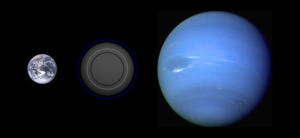Names
If you are acquainted with the rings of Saturn and the rings of Uranus, the rings of Neptune may surprise you. Ordinary capital letters supply names for the principal rings of Saturn. They are called the A Ring, B Ring, C Ring, etc. Similarly, most of the rings of Uranus are named after Greek letters. So we would naturally expect the rings of Neptune to bear the names of Arabic or Russian letters, or perhaps Chinese characters.
The scientists who named Neptune’s rings had a different idea. They named the rings after people who were somehow associated with the planet Neptune. The innermost ring is called Galle. His name commemorates the discovery of the planet Neptune by the German astronomer Johann Gottfried Galle in 1846. The next closest ring is called LeVerrier after Urbain Jean Joseph LeVerrier, who calculated the position of Neptune from its gravitational effect on Uranus and told Galle where he could find this new planet. The next closest ring is “a faint outward extension of the LeVerrier Ring,” according to NASA. It is called the Lassell Ring in honor of William Lassell, who discovered Triton, the largest moon of Neptune. Next comes the Arago Ring, named after the French astronomer Dominique François Jean Arago, who invented the polariscope. The outermost ring is the Adams Ring. Like Leverrier, John Couch Adams calculated the position of Neptune before the planet was actually discovered. He told an astronomer named Airy where he could find it, but the Airy did not act on the information. Consequently, Neptune does not have any Airy Ring.
Discovery of the Rings
In 1977, Elliot, Dunham and Fink discovered rings of Uranus when they observed a star as the planet was moving in front of it. Whenever the star was directly behind a ring, the starlight temporarily appeared dimmer; so the three astronomers correctly concluded that rings were obstructing the passage of light.
This inspired Edward Guinan and others to look for Neptunian rings when the planet moved in front of a star. However, the results were perplexing. Sometimes the starlight dimmed when ring material passed in front of it, but sometimes it did not.
When Voyager 2 finally reached Neptune in 1989, it was discovered that Neptune had rings that were not uniform in composition. The rings did not always dim the starlight because some parts of the rings contained fewer particles.
In case of the Adams Ring, some of the more opaque parts were given names. From pictures taken by Voyager 2, it was learned that the Adams Ring contained several ring arcs, which were called Liberté, Egalité, and Fraternité, which is French for Liberty, Equality, and Fraternity.
Dark Albedo of the Rings
The rings of Neptune do not reflect much light. They are much darker than the principal rings of Saturn.
A ring consists of many small bodies that revolve around their mother planet. Whether the rings are dark or light depends on the materials of which the revolving bodies are made.
Obviously, it is not currently possible to take one of these revolving bodies into the laboratory and examine its material microscopically. However, I suspect that not too many of them are made of ice, since ice reflects light efficiently. They are probably made of rock.
Distance from Neptune
The Galle Ring is about 41,900 km from the center of Saturn, and the Adams Ring is about 62,933, according to NASA. The other three rings lie between these two.
Four of the 27 Neptunian moons thus far discovered have orbits that are closer than 62,933 km from the center of the mother planet. Their gravitational attraction undoubtedly has some influence on the particles of the rings. The names of these four moons are Naiad, Thalassa, Despina, and Galatea.
Note: There are actually six Neptunian rings that have been discovered. One has not yet received an official name.
References:
NASA: Neptune – Rings
http://solarsystem.nasa.gov/planets/profile.cfm?Object=Neptune&Display;=Rings
Universe Today: Rings of Neptune
European Space Agency: Neptune
http://www.esa.int/esaKIDSen/SEM7CTMZCIE_OurUniverse_0.html
Space: Neptune, the Other Blue Planet in the Solar System
http://www.space.com/41-neptune-the-other-blue-planet-in-our-solar-system.html
